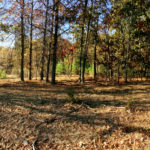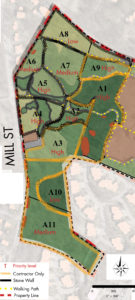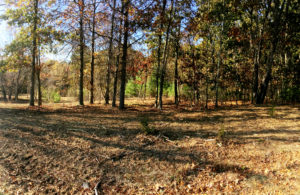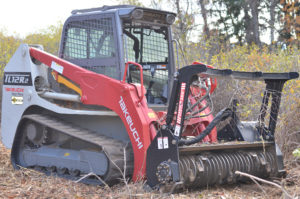
By Jeffrey North
On November 3, field technicians engaged by the Land Management Committee for Lone Tree Hill (LMC) and the Judy Record Conservation Fund began a multi-year campaign to restore select parcels of the Lone Tree Hill conservation land. This initial project focused on invasive plant removal at Area A1, where horticulturalists from Parterre Ecological Services began restoration of the shrub layer by hand-cutting the bittersweet vines that were smothering the largest trees and employing a forestry mower to cut down the buckthorn and multiflora rose.
Lone Tree Hill—like public, private, and protected lands elsewhere—is gradually being overrun by invasive non-native plant species. These insidious foes have the assured destructive capability to dramatically reduce the tree canopy, overrun the native shrub layer, change the chemistry of the soil, and reduce biodiversity as the aesthetic value of the property is likewise degraded. (See “Committee Plans Lone Tree Hill Restoration,” Belmont Citizens Forum Newsletter, July/August 2020.)
The plan includes a mapped, prioritized inventory of invasive plants at sites across the property and more than 25 projects for removal and replanting, each with recommendations for initial treatment and ongoing maintenance. The strategy for the restoration of LTH has been documented in the Invasive Plant Management and Native Plant Restoration Plan study by Parterre Ecological Services which was presented to the LMC in May 2020.
With matching support from the Judy Record Conservation Fund, the LMC has embarked on an ambitious plan to restore the conservation land and continue the work of Judy Record and a committed group of Belmont citizens that began even before the town acquired the 113-acre property from McLean Hospital more than 20 years ago. (See “A Tribute to Judith K. Record’s Legacy,” Belmont Citizens Forum Newsletter, January/February 2016.)

A partial map of Lone Tree Hill showing mapped areas and their rating for density of invasive species. Area A1 is in the upper right. Source: Parterre Ecological Services
Area A1: Overwhelmed
Area A1 is the parcel that is deemed the highest priority for invasive plant species treatment at LTH because it contains the densest populations of invasive plants. Species ranging from impenetrable multiflora rose (Rosa multiflora), tree of heaven (Ailanthus altissima), thick oriental bittersweet vines (Celastrus orbiculatus) to patches of glossy buckthorn (Frangula alnus) have overwhelmed the native plant community.
In the Invasive Plant Management and Native Plant Restoration Plan, horticulturalists recommend that Area A1 be cut by a forestry mower and later replanted (manually or naturally) with native shrubs and trees. This 100,000 square foot forested area is not being clear-cut. Native trees have been flagged for preservation and possible seed collection for the replanting effort which will continue over the next two to three years. Native tree species in the area include ash, hickory, black cherry, hazelnut, sugar maple, dogwood, bigtooth aspen, sumac, and catalpa. These trees are presently adorned with red ribbons to indicate their preservation.
Next steps
This campaign could eventually move across the land to protect the red maple wetland brook and the diverse mix of summersweet and highbush blueberry bushes, as well as tree species including green ash, hazelnut, bitternut hickory, Norway spruce, silver and sugar maples, Eastern red cedar, bigtooth aspen, black cherry, and white, red, and pitch pines.
After forestry mowing of Area A1, the recommendation is to seed the area with meadow plants and replant it with native shrubs. The vegetation in the surrounding area can indicate what plants will colonize the newly disturbed area. But the war will go on.
We expect to see the aggressive invaders colonizing the new open space. Ideally, these plants should be removed. To prevent their encroachment, we should sow the sunny open spaces with a native annual cover crop. With monitoring, we should be able to assess which areas of the site will be most effectively restored with either natural regeneration (allowing nature to choose what springs up and succeeds unaided), or various degrees of assisted regeneration (actively cultivating and promoting selected plant species by seeding, planting and cultivation of chosen plant species).
Reasons for herbicide use
The work remaining on the current project in Area A1 includes two foliar herbicide applications to be applied in early 2021 by licensed technicians trained in plant identification. These treatments will greatly retard growth of sprouting invasive plants.
The decision to use herbicide was carefully weighed by considering multiple factors, such as the density of invasive plants (high) and strength of the seed bank (high), the likelihood of plants resprouting from roots left in the ground during manual removal (certain), the cost of alternative methods (very high), damage to soil structure and nutrients by manual methods (certain), and the size of the area (large).
Short-lived systemic herbicides carefully and selectively applied will kill the invasive plants above ground and at the roots, preventing the need to dig deep into the soil, which can encourage the invasive seed bank to germinate. After one or two seasons of management, the soil can be seeded with a native cover crop, and restoration with native plants can move forward. We want to have a rapid, decisive impact in moving Lone Tree Hill back to a healthy native plant community. Selective foliar herbicide application with a backpack sprayer in densely invasive areas, and cut stump treatment of individual sprouts with a brush or glove in moderately dense areas are the least costly, most effective means to convert Area A1 to a native plant community.
For more information on invasive plant treatment, see bit.ly/BCFUNHinvasives
The Land Management Committee for Lone Tree Hill is deeply grateful to the trustees of the Judy Record Conservation Fund for their continuing support of the maintenance and improvement of this valuable and treasured conservation land.
The author wishes to acknowledge the generous assistance, observations, and field notes of Gabriel Siegel, MCH, Crew Leader; and Miles Connors, MALD, MCH; Director, Parterre Ecological Services.
Jeffrey North is the ex-officio Belmont Conservation Commission representative on the Land Management Committee for Lone Tree Hill.




Sorry, the comment form is closed at this time.